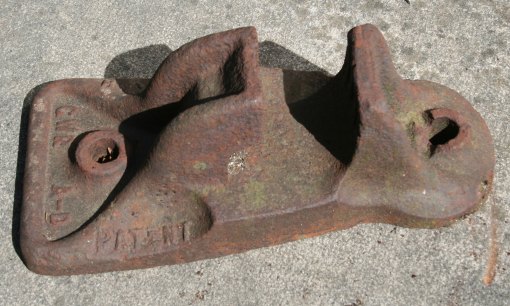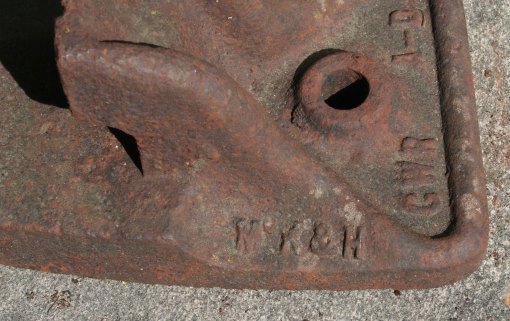Ref:- Quirky Query 2 – GWR PW in Victorian times
We left Quirky Query 2 with some photos of a GWR rail chair (in my care) and the question… “is the chair an example of the type for the 86lbs rail of 1882 ?”. None of the comments on that post have provided a definitive answer… rather those comments have deepened the puzzle. In the meantime, Adrian and I had concluded that the sidings in Gun Street depot were subject to frequent renewal and so the model shall portray the GW PW of the mid 1890s rather than of the early 1880s. However, the comments to Quirky Query 2, combined with new photographs, suggested that there is more to the original post than was thought. In taking this story forward, I am glad to acknowledge that the comments on QQ-2 awakened a recollection as to where I might find some contemporary material. A recent bright and sunny day provided the ideal opportunity to do some detective work and the results are presented here.
Our railway “heritage” sites provide railway historians with many opportunities to study artefacts from an earlier age and none more so than with bits and pieces from the railway infrastructure – in this case the simple rail chair. At one particular heritage site an unknown person has “collected” examples of chairs from a range of pre-group companies…. and that collection includes a couple of chairs which are very similar to my example. The photographs below show an example of the type with raised rather than recessed lettering – just as predicted in a comment to QQ2.
The first photograph shows a side view of the chair – with the word “patent” visible in raised letters.
The second photograph shows an end view – with “GWR” and “A-D” in raised letters. I hope that a reader can explain the significance of “A-D”. In passing, note the grooves to the inner face of the far jaw… a feature which is discussed later in this post.
The third photograph is another side view – and shows yet more raised lettering,”Mc K & H” which I feel is likely to be McKenzie & Holland (a signalling contractor).
The Malvern Industrial Archeology Circle website offers an outline of the history of Mckenzie & Holland where the origins of the signalling manufacturer is recorded as “Thomas Clunes”, iron and brass founder of the “Vulcan Iron Works” in Worcester. McKenzie & Holland as a company name dates from the mid-1870s which means that the chair in the photograph is post circa-1875. What aspect of the chair is the subject of the “patent” is not yet known to me.
Returning to the chair in the original QQ2 post, the similarities between that chair and the casting above are very strong, the only significant differences are the lettering and the manner in which the lettering is represented – comments to QQ2 noted that raised letters are easier than recessed letters for cast items… and that the “pattern” for the chair casting was likely to have been made as a metal item (from a wooden master with double shrinkage allowances). In the absence of any information about the nature of either the “patent” or the business relationship for supply of castings – the possibility exists that the GWR bought the patent-rights from McK & H and thereby gained a metal pattern for the cast-iron chair. Removal of the raised lettering on the metal pattern would be fairly easy – building up new lettering would be difficult and hence one can suggest that the new lettering was “engraved” into the metal pattern hence the recessed lettering on my chair.
As for the vertical grooves in the jaw, Harvie (1898) records that the GWR had been experimenting with spring clips as an alternative to oak or teak keys. The relevant text refers to a circular spring clip being inserted into the space between the jar and the rail with the ends of the clip bearing on the rail. Whilst not conclusive the grooves on the face of the jaw may be related to the use of such clips.
Unfortunately none of the above furthers the case for the original question… however, the similarity of my chair to the McK & H specimen puts the likely date of casting as contemporary with the introduction of the 86lbs rail in 1882.
Graham



Leave a comment